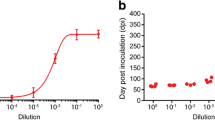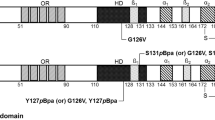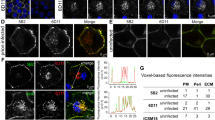Abstract
THE infectious agent (or 'prion') of the transmissible spongiform encephalopathies (TSEs) such as scrapie resembles a virus in that it replicates in vivo and has distinct strains1, but it was postulated long ago to contain only protein2,3. More recently, PrPSc, a pathogenic, scrapie-associated form of the host-encoded prion protein (PrP), was identified as a possible primary TSE agent protein4–6. PrPSc is defined biochemically by its insolubility and resistance to proteases7 and is derived post-translationally from normal, protease-sensitive PrP (PrPc)8,9. The conversion seems to involve conformational change rather than covalent modification10–13. However, the conversion mechanism and the relationship of PrPSc formation to TSE agent replication remain unclear. Here we report the conversion of PrPc to protease-resistant forms similar to PrPSc in a cell-free system composed of substantially purified constituents. This conversion was selective and required the presence of preexisting PrPSc, providing direct evidence that PrPSc derives from specific PrPc–PrPSc interactions.
Similar content being viewed by others
References
Rohwer, R. G. Curr. Topics Microbiol. Immun. 172, 195–232 (1991).
Pattison, I. H. & Jones, K. M. Vet. Rec. 80, 2–9 (1967).
Griffith, J. S. Nature 215, 1043–1044 (1967).
Bolton, D. C. McKinley, M. P. & Prusiner, S. B. Science 218, 1309–1311 (1982).
Diringer, H. et al. Nature 306, 476–478 (1983).
Prusiner, S. B. Science 252, 1515–1522 (1991).
Meyer, R. K. et al. Proc. natn. Acad. Sci. U.S.A. 83, 2310–2314 (1986).
Caughey, B. & Raymond, G. J. J. biol. Chem. 266, 18217–18223 (1991).
Borchelt, D. R., Scott, M., Taraboulos, A., Stahl, N. & Prusiner, S. B. J. Cell Biol. 110, 743–752 (1990).
Hope, J. et al. EMBO J. 5, 2591–2597 (1986).
Caughey, B. W. et al. Biochemistry 30, 7672–7680 (1991).
Pan, K.-M. et al. Proc. natn. Acad. Sci. U.S.A. 90, 10962–10966 (1993).
Stahl, N. et al. Biochemistry 32, 1991–2002 (1993).
Safar, J., Roller, P. P., Gajdusek, D. C. & Gibbs, C. J. Jr J. biol. Chem. 268, 20276–20284 (1993).
Caughey, B., Race, R. E., Ernst, D., Buchmeier, M. J. & Chesebro, B. J. Virol. 63, 175–181 (1989).
Taraboulos, A. et al. Proc. natn. Acad. Sci. U.S.A. 87, 8262–8266 (1990).
Bolton, D. C. & Benheim, P. E. In Novel Infectious Agents and the Central Nervous System Vol. 1 (eds Bock, G. & Marsh, J.) 164–181 (Wiley, Chichester, 1988).
Brown, P., Goldfarb, L. G. & Gajdusek, D. C. Lancet 337, 1019–1022 (1991).
Jarrett, J. T. & Lansbury, P. T. Jr Cell 73, 1055–1058 (1993).
Snow, A. D. et al. Lab. Invest. 63, 601–611 (1990).
Aiken, J. M. & Marsh, R. F. Microbiol. Rev. 54, 242–246 (1990).
Riesner, D. Semin. Virol. 2, 215–226 (1991).
Caughey, B. & Raymond, G. J. J. Virol. 67, 643–650 (1993).
Weissmann, C. Nature 352, 679–683 (1991).
Come, J. H., Fraser, P. E. & Lansbury, P. T. Jr Proc. natn. Acad. Sci. U.S.A. 90, 5959–5963 (1993).
Fraser, H. Br. med. Bull. 49, 792–809 (1993).
Prusiner, S. B., Groth, D. F., Bolton, D. C., Kent, S. B. & Hood, L. E. Cell 38, 127–134 (1984).
Caughey, B., Raymond, G. J., Ernst, D. & Race, R. E. J. Virol. 65, 6597–6603 (1991).
Chesebro, B. et al. Dev. biol. Stand. 80, 131–140 (1993).
Rogers, M., Yehiely, F., Scott, M. & Prusiner, S. B. Proc. natn. Acad. Sci. U.S.A. 90, 3182–3186 (1993).
Author information
Authors and Affiliations
Rights and permissions
About this article
Cite this article
Kocisko, D., Come, J., Priola, S. et al. Cell-free formation of protease-resistant prion protein. Nature 370, 471–474 (1994). https://doi.org/10.1038/370471a0
Received:
Accepted:
Issue Date:
DOI: https://doi.org/10.1038/370471a0
- Springer Nature Limited
This article is cited by
-
Seed amplification assay for the detection of pathologic alpha-synuclein aggregates in cerebrospinal fluid
Nature Protocols (2023)
-
Prion strains: shining new light on old concepts
Cell and Tissue Research (2023)
-
RT-QuIC as ultrasensitive method for prion detection
Cell and Tissue Research (2023)
-
PMCA for ultrasensitive detection of prions and to study disease biology
Cell and Tissue Research (2023)





